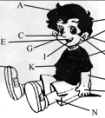从方框内选择合适的短语,并用其适当形式完成句子。used to,be careful of,use up, escape from,be afraid of1. Boys and girls, _______ the traffic.2. He has _______-九年级英语
4.不能与when连用.
现在完成时的用法:
1.表示动作发生在过去某个不确定的时间,但对现在留下了某种影响和结果。常被just、already、yet 等副词修饰。如:
-Have you had lunch yet?
-Yes,I have. I've just had it.
2.表示从过去某一时刻开始一直持续到现在的动作或状态。这个动作可能刚停止,可能仍然在进行。
常带有for和since等表示一段时间的状语。如:
He has taught here since 1981
他自1981年就在这儿教书。(可能还要继续教)
I have't seen her for four years.
我有四年没见到她了。
3.表示说话前发生过一次或多次的动作,现在成为一种经验,一般译为汉语“过”。
常与twice,ever,never,three times等时间状语。 如:
I have been to Beijing twice.我去过北京
4. 现在完成时还往往可以同包括现在时间在内的时间状语连用,如:
now,up to these few days/weeks/months/years,this morning/week/month/year,just,today,up to present,so far等:
Peter has written six papers so far.
Man has now learned to release energy from the nucleus of the atom.
There has been too much rain in San Francisco this year.
The friendly relations and cooperation between our two countries have been enhanced in the past few years.
Up to the present everything has been successful.
5.现在完成时往往同表示不确定的过去时间状语连用,如:
already(肯定),yet(否定,疑问),just,before,recently,still,lately,never等:
He has already obtained a scholarship.
I haven't seen much of him recently (lately).
We have seen that film before.
Have they found the missing child yet?
6.现在完成时的"完成用法"
现在完成时的"完成用法"指的是动作发生在过去某一时刻并已结束,但该动作对现在产生了影响,与现在情况具有因果关系。
例如:
He has turned off the light.他已把灯关了。(动作结束于过去,但说明的是现在的情况--灯现在不亮了。)
现在完成时"完成用法"的特点是动作不延续,因此:
该时态只能与表示不定的过去时间状语(如:already,yet,before,recently等)、频度时间状语(如:never,ever,once等)、包括现在时刻在内的时间状语(如:this morning / month /year...,today等)连用。
例如:Have you found your pen yet?你已找到你的钢笔了吗?
7.现在完成时的"未完成用法"
现在完成时的"未完成用法"指的是动作开始于过去某一时刻,一直延续到现在,或可能还要继续下去。
例如:
He has lived here since 1978.自从1978年以来,他一直住在这儿。
(动作起始于1978年,一直住到现在,可能还要继续住下去。)
I have been in the army for more than 5 years.我在部队已经呆了五年多了。
(动作开始于5年前,一直延续至今,有可能还要继续下去。)
此种用法的句中常需一个表示一段时间的状语(由since或for引导),或表示与现在时刻相连的时间状语(如:up to now,so far)等。
例如:
I have heard nothing from him up to now.到目前为止我没有他的任何消息。
注意:现在完成时的未完成用法只适用于延续性动词,不可用于终止性动词,即瞬间完成或延续时间很短的动词。
如:come,go,arrive,leave,join,become,die等。
8.一段时间+has passed+since从句
主语+have / has been+since短语
例如:He has been in the League for three years.
或It is three years since he joined the League. 他入团已三年了
9. 现在完成时常和短语 "up to now /till now","so far" (意思是从过去某一确定的时间一直延续到现在)连用。
Up to/till now he's read many story books. 至今他已读过好多故事书。
I've been to New York three times so far. 至今我已到纽约去过三次。
has gone (to),has been (to),has been (in) 的区别
has gone to:去了没回
has been to :去过
has been in:呆了很久
考点名称:主谓一致
- 英语中的一致主要包括主语和谓语在人称和数上的一致、时态一致、名词和其代词的一致。
主语和谓语保持一致叫主谓一致,即谓语动词的形式必须随着主语单、复数形式的变化而变化。 - 主谓一致原则:
1、语法上的一致
所谓语法一致原则,即主语和谓语的语法形式在人称和数上取得一致。
谓语的单、复数形式依据主语的单、复数形式而定:主语为复数,谓语动词用复数;主语为单数或者是不可数名词,谓语动词用单数。
China belongs to the Third World. 中国属于第三世界。
We are sure he will come. 我们肯定他会来。
使用语法一致的情况
(1)当主语是and,both…and连接的并列结构
如果主语指的是两个或两个以上的人或物,则谓语动词用复数。
My mother and I have seen the film. 我妈妈和我已看过这部电影。
Both rice and wheat are grown in this part of China. 在中国的这个地方既种稻子又种小麦。
注意:由and连接的并列主语前面分别有each,every,no修饰时,其谓语动词用单数形式。
Every boy and every girl has to receive education in our country. 在我国每一个男女孩子都得受教育。
No student and no teacher was invited to the party. 师生没有被邀请参加晚会。
(2)主语后面接说明主语的修饰语
主语后面接说明主语的修饰语如:
with,along with,together with,as well as,like,rather than,but,except,besides,including,in addition to,
谓语动词不受修饰成分的影响,仍保持同主语一致的关系。
The teacher with two students was at the meeting. 那位老师和两个学生参加了会议。
The girl as well as the boys has learned to drive a car. 这个姑娘和男孩子一道,也学会了开汽车。
A library with five thousand books is offered to the nation as a gift.一个有5000册书的图书馆作为礼物赠送给了国家。
E-mail, as well as telephones, is playing an important part in daily communication.电邮和电话在日常的通信中起着很重要的作用。
Nobody but Jane knows the secret.只有简知道这个秘密。
All but one were here just now. 刚才除了一个人外都来了。
(3)非谓语动词或从句作主语
非谓语动词 (动词的-ing形式、不定式)或从句作主语时,谓语一般用单数形式。
When and where to build the new factory is not decided yet.什么时候在什么地方建新工厂还没定下来。
Checking information is very important. 核实事实是非常重要的。
To learn foreign languages is not easy. 学习外语并非易事。
When we will hold the meeting is not decided yet. 我们何时开会尚未决定。
注意:当what引导主语从句或由 and连接两个动词不定式或动名词作主语时,谓语动词的数应根据意义一致的原则来决定。
What we need here is money.我们这里需要的是资金。
What we need here are workers.我们这里需要的是工人。
Lying and stealing are immoral.说谎与偷窃是不道德的。
(4)each和复合不定代词作主语
each和some/any/no//every十body/one/thing构成的复合不定代词:
anyone、anybody、anything、everyone、everybody、everything、someone、somebody、something、no one、nobody、nothing、each、the other作主语,谓语动词用单数。
Each is worse than the one before. 一个比一个差。
Nobody knows the answer. 没有一个人知道这答案。
Someone wants to see you. 有人想见你。
Is there anything in the box?箱子里有什么东西吗?
There is a lot of milk in the bottle. 瓶子里有很多奶。
(5)“many a +单数名词”作主语
“many a、(很多)/more than one(不只一个)+单数名词”作主语时,谓语动词用单数形式。
Many a student has been to Beijing. 很多学生去过北京。
There is more than one answer to your question. 你的问题不只有一个答案。
(6)“one of+复数名词十定语从句”之前有the等限定词和修饰语
“one of+复数名词十定语从句”之前有the only,the very,the等限定词和修饰语时,定语从句的谓语动词用单数形式。
Tom is the only one of those boys who is willing to help the old man.
汤姆是唯一的一个愿意帮助那个老人的男孩。
He is the only one of the students who has been a winner of scholarship for three years.他是这三年来唯一的一个获得奖学金的学生。
注意:如没有这些限定词和修饰语,定语从句的谓语动词采用复数形式。
Tom is one of the boys who are always ready to help others. 汤姆是个随时愿意帮助别人的男孩。
(7)由两个部分组成的物体名词作主语
英语中有些由两个部分组成的物体名称如g1asses(眼镜),scissors(剪刀),shorts(短裤),shoes(鞋子),trousers(裤子)等作主语,其后的谓语动词用复数形式。
His glasses were broken, so he can't see well. 他的眼镜碎了,因而看不清楚。
His trousers are made of cotton. 他的裤子是棉布的。
注意:若这类名词前带有pair等表示单位的名词时,则以这些名词的单、复数形式决定动词的形式。
- 最新内容
- 相关内容
- 网友推荐
- 图文推荐
| [家长教育] 孩子为什么会和父母感情疏离? (2019-07-14) |
| [教师分享] 给远方姐姐的一封信 (2018-11-07) |
| [教师分享] 伸缩门 (2018-11-07) |
| [教师分享] 回家乡 (2018-11-07) |
| [教师分享] 是风味也是人间 (2018-11-07) |
| [教师分享] 一句格言的启示 (2018-11-07) |
| [教师分享] 无规矩不成方圆 (2018-11-07) |
| [教师分享] 第十届全国教育名家论坛有感(二) (2018-11-07) |
| [教师分享] 贪玩的小狗 (2018-11-07) |
| [教师分享] 未命名文章 (2018-11-07) |






